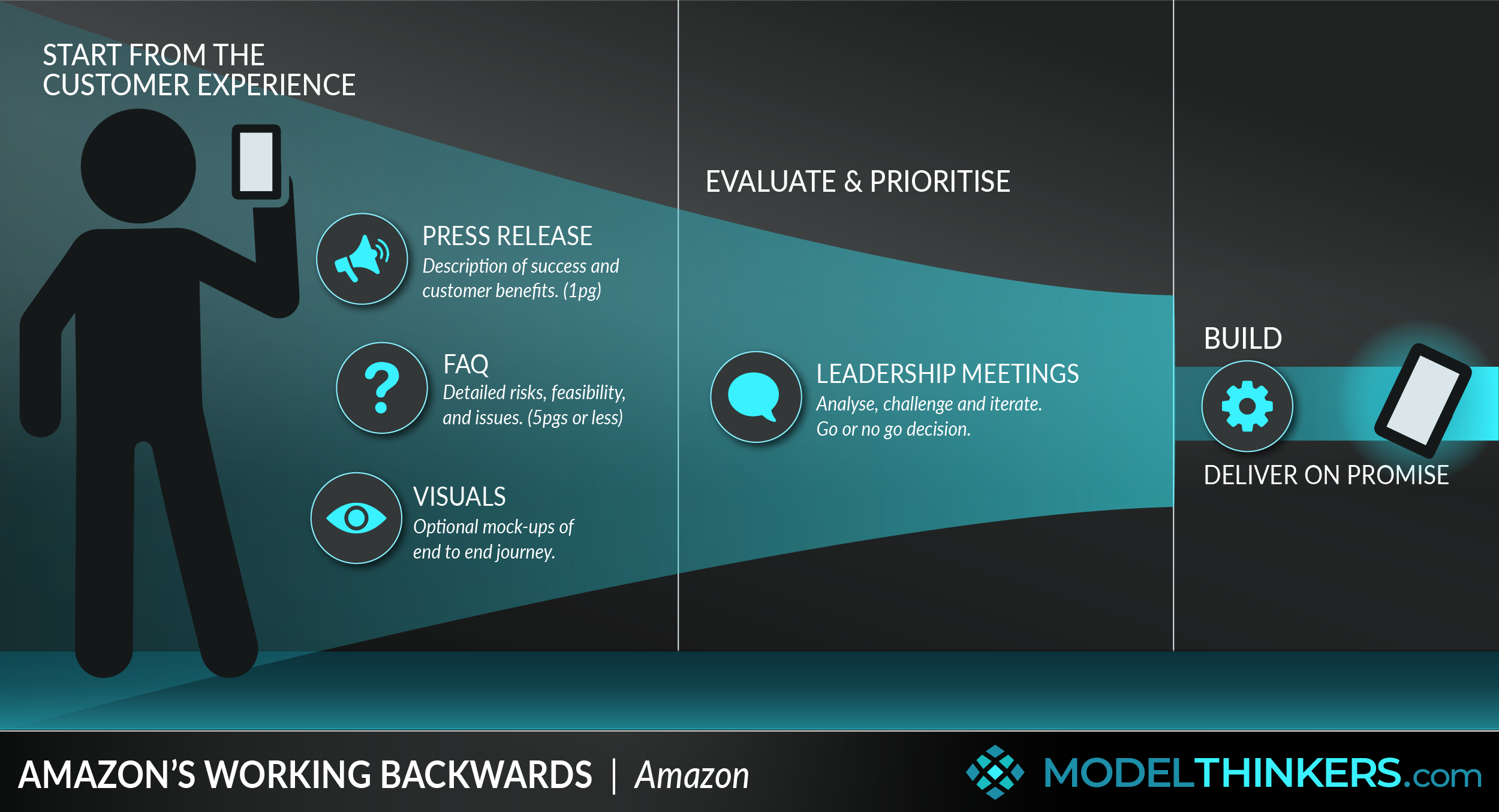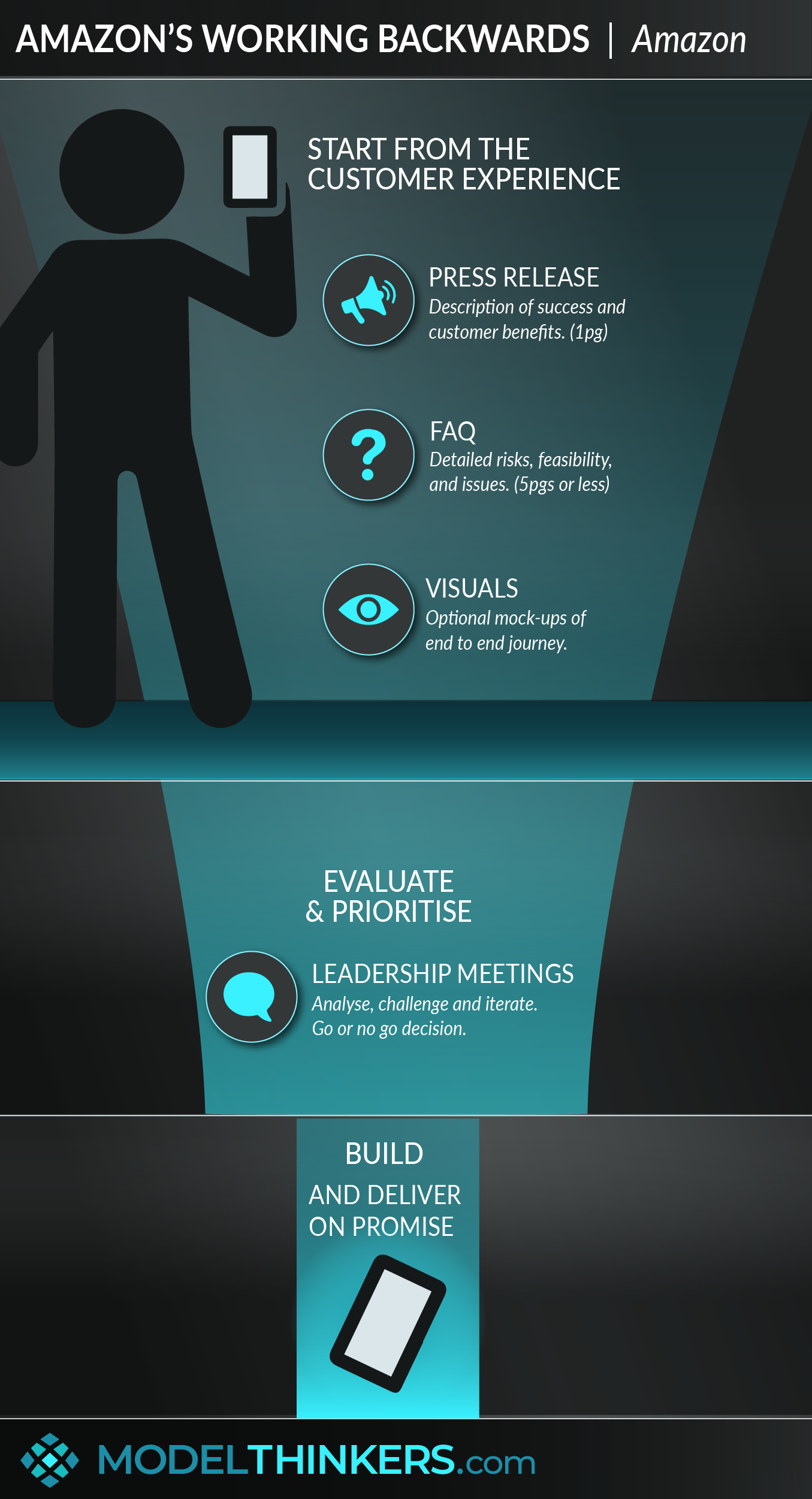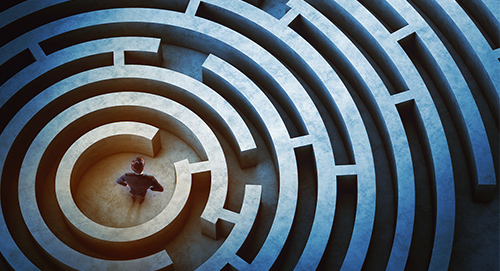

 0 saved
0 saved
 36.2K views
36.2K views








Amazon’s mission statement includes a commitment “to be Earth’s most customer-centric company”; Jeff Bezos enforced the ‘one empty chair rule’ in meetings to represent customers; and his constant call to "Start with the customer and work backwards" is part of Amazon’s Leadership Principles. So it’s no surprise that such thinking is baked into Amazon’s processes.
Amazon’s Working Backwards approach, also known as PR/FAQ, involves starting large initiatives by writing a press release and FAQ document to succinctly express its value from a customer-centric perspective; evaluating and iterating it with leadership critiques; and finally working backwards to establish how to deliver on its promise.
THE PRESS RELEASE.
The Press Release (PR) imagines a successful launch and captures the customer value or ‘so what?’ in a single page. It must quickly outline how the product is faster/ easier/ cheaper for a customer pain point in plain English. The main elements of the PR include:
- Heading: a customer-relevant title.
- Subheading: an additional line about the customer benefits.
- Summary paragraph: like an exec summary, this is a short description summarising the primary value and benefits.
- Problem paragraph: an outline of the problem being solved and target audience.
- Solution paragraph: how the product addresses the problem.
- Quotes: including a company quote and testimonial from a hypothetical customer.
- Getting started: a call to action and/or next steps.
THE FAQ AND VISUALS.
The FAQ provides details about the approach, addressing key issues from an external customer perspective and exploring the economics, risks and challenges from an internal business perspective. The external questions are practical things that customers might ask including how it works and how to buy it.
The internal questions typically include an analysis of consumer need and Total Addressable Market (TAM), or the potential market for the product. Questions to establish this are:
- How many consumers have this need or problem?
- How big is the need?
- For how many consumers is this problem big enough that they are willing to spend money to do something about it?
- If so, how much money would they be willing to spend?
- How many of these consumers have the characteristics/capabilities/constraints necessary to make use of the product?
The internal section of the FAQ also has a Profit and Loss (P&L) outline, answering questions about the per-unit economics; the expected gross profit and contribution profit; the rationale for the price point; how much investment will be required upfront etc.. This section would also address broader questions around dependencies and feasibility.
While not always included, there is a preference towards including mockups and wireframes in the appendix of the document to preview the customer experience. The idea is to match the prototype fidelity with the maturity of the idea. In Amazon’s context, it would typically involve previewing the experience from the landing page to purchase point, and perhaps even delivery.
EVALUATION.
Once created, the PR/FAQ documents are critiqued by leadership meetings. These start with everyone reading the document to themselves, then move onto high-level feedback before working through each paragraph to challenge, identify gaps, and provide detailed feedback.
While many PR/FAQ documents are iterated and improved, most are never developed let alone see their product launched. Advocates see this as a 'feature rather than a bug', explaining that upfront investment in ideas promotes innovation and customer-centricity. Indeed, Bezos was known for pushing ahead with some projects even with unanswered questions, if the perceived TAM and rewards were large enough.
IN YOUR LATTICEWORK.
This model aligns with Amazon’s High-Velocity Decisions approach and can be combined with other product design frameworks such as RICE Score and the Kano Model. The visual element requires Prototypes. The process of presenting a PR/FAQ to a meeting obviously depends on Psychological Safety and would also be sharpened by models such as Value Proposition, Personas, Empathy Maps and Journey Maps.
One criticism of this approach is that it requires too much upfront definition rather than, for example, taking a Minimum Viable Product or Riskiest Assumption Test approach to quickly test assumptions and gain consumer feedback. That said, they do not need to be counterposed and the PR/FAQ can be a living document that reflects iterative learning from customers.




- Start with the end in mind.
In the words of Stephen Covey, "Start with the end in mind." Before you start a project, define the endpoint in some detail and focus on the actual customer experience as a result of your work.
-
Write the press release first.
Writing a one-page press release to distill the main customer benefits and ‘so what’ of your planned work. It will help to expose your assumptions and becomes your way of quickly explaining and testing the value of the project. Some internal teams write an internal or marketing blog post as a variation on this.
-
Write the FAQ.
The FAQ demonstrates detailed thinking from a customer perspective as well as addressing basic business questions of feasibility, operations, and economics. It’s an opportunity to explore risks, challenges and even identify areas that need further investigation. Importantly it should define the potential market and returns of the initiative.
-
Have the discussions.
Use your documents to have frank conversations with peers and leaders. Allow them to brief themselves by reading the document before you work through high-level responses and then detailed analysis of the approach. Use the feedback to iterate, identify gaps, and learn.
-
Still take risks.
Using this process might stop a lot of product or initiatives before they start, so it’s important not to get overly connected to any particular idea. That said, there are also times to ensure that you take a risk, even if not all questions are answered, when the customer impact and returns are potentially high.
This approach can be subject to ‘vapourware’, or the process of selling a product that doesn’t exist. But that risk is only an issue if the PR/FAQ information goes public, given that this process is more about internal development.
The other more substantial criticism is that this approach might not allow for an iterative process of discovery and requires too much work upfront. This is particularly the case for projects that are more complex (see the domain definition from Cynefin) and require greater experimentation upfront to gain more feedback and information rather than a distant fixed goal.
For example, delivering a Minimum Viable Product will allow testing of the market and gain consumer feedback rather than trying to work out everything upfront in a document. A counterargument in defence of the Amazon approach is that, when applied effectively, the Working Backwards method needn't lock you in — rather it can serve as an initial hypothesis that can be refined with further prototyping and development — and the PR/FAQ documents can be updated with such learning.
Amazon Kindle 2007.
The authors of Working Backwards described their experience of developing Kindle in 2007.
“When we wrote a Kindle press release and started working backwards, everything changed. We focused instead on what would be great for customers. An excellent screen for a great reading experience. An ordering process that would make buying and downloading books easy. A huge selection of titles. Low prices. We would never have had the breakthroughs necessary to achieve that customer experience were it not for the press release process, which forced the team to invent multiple solutions to customer problems.”
Sony example from Bezos.
In explaining this approach to the team, Bezos talked through a hypothetical example with Sony. He said to imagine that a sales and marketing group had analysed customer preferences and market trends, but not necessarily customer experience, and determined an opportunity for a 44-inch TV at $1,999. Meanwhile, the engineering team had been working on developing better picture quality rather than being concerned about price.
Bezos explained: “If the two organizations had started the process by writing a press release, they would have had to agree on the features, cost, customer experience, and price. Then they could have worked backwards to figure out what to build, thereby surfacing the challenges they would face in product development and manufacturing.”
d
This approach has been used in Amazon for most major projects since 2004, having been directed and developed by Jeff Bezos in consultation with a range of product teams. Ian McAllister, a Director at Amazon, talked about it in this popular Quora response in 2012.
The technique has also recently been described in detail by ex-Amazon executives Colin Bryar and Bill Carr in their 2021 book Working Backwards.
 My Notes
My Notes
Oops, That’s Members’ Only!
Fortunately, it only costs US$5/month to Join ModelThinkers and access everything so that you can rapidly discover, learn, and apply the world’s most powerful ideas.
ModelThinkers membership at a glance:






“Yeah, we hate pop ups too. But we wanted to let you know that, with ModelThinkers, we’re making it easier for you to adapt, innovate and create value. We hope you’ll join us and the growing community of ModelThinkers today.”





















































































